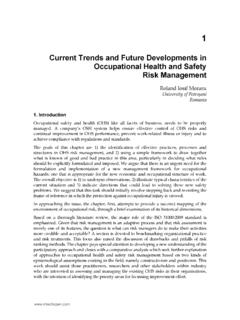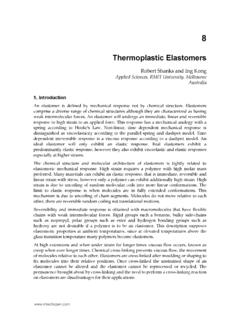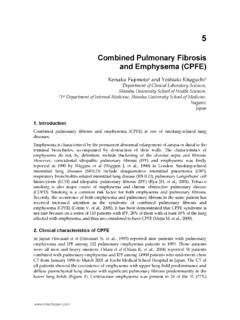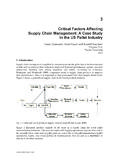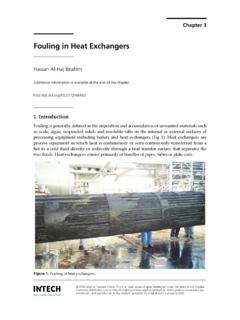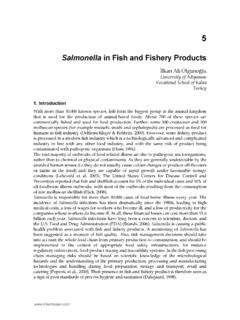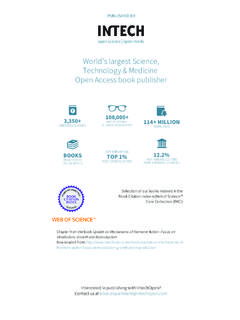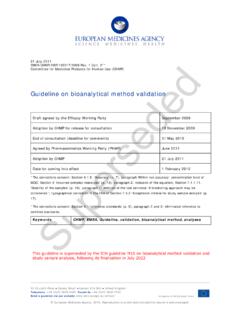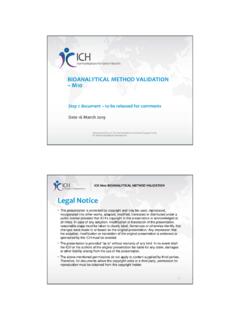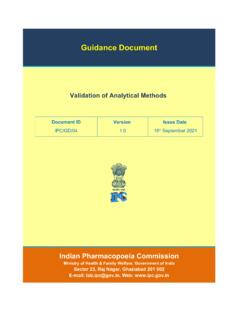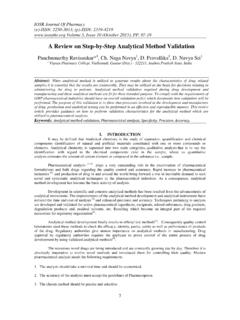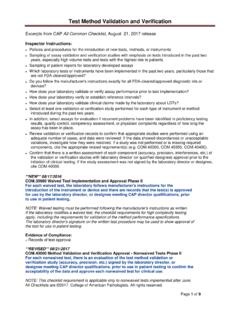Transcription of Method Development and Validation of Analytical …
1 1 Method Development and Validation of Analytical Procedures Kapil Kalra Dev Bhoomi Institute of Pharmacy and Research, Dehradun, Uttarakhand, India 1. Introduction Method Validation is the process used to confirm that the Analytical procedure employed for a specific test is suitable for its intended use. Results from Method Validation can be used to judge the quality, reliability and consistency of Analytical results; it is an integral part of any good Analytical practice. It is the process of defining an Analytical requirement, and confirms that the Method under consideration has performance capabilities consistent with what the application requires.
2 Use of equipment that is within specification, working correctly and adequately calibrated is fundamental to the Method Validation process. Likewise the operator carrying out the studies must be competent in the analysis under study and have sufficient knowledge of the Method /analysis to draw conclusions from the observations as the Validation work proceeds. Quite often Method Validation evolves from Method Development and so the two activities are often closely tied, with the Validation study employing the techniques and steps in the analysis as defined by the Method Development .
3 Analytical methods need to be validated or revalidated before their introduction into routine use; whenever the conditions change for which the Method has been validated ( , an instrument with different characteristics or samples with a different matrix); and whenever the Method is changed and the change is outside the original scope of the Method . Method Validation has received considerable attention in the literature and from industrial committees and regulatory agencies. The FDA CGMP request in section (e) methods to be validated: The accuracy, sensitivity, specificity, and reproducibility of test methods employed by the firm shall be established and documented.
4 Such Validation and documentation may be accomplished in accordance with Sec. (a). These requirements include a statement of each Method used in testing the sample to meet proper standards of accuracy and reliability, as applied to the tested product. The FDA has also proposed industry guidance for Analytical Procedures and methods Validation . ISO/IEC 17025 includes a chapter on the Validation of methods with a list of nine Validation parameters. The ICH has developed a consensus text on the Validation of Analytical procedures.
5 The document includes definitions for eight Validation characteristics. ICH also developed guidance with detailed methodology. Quality Control of Herbal Medicines and Related Areas 4 The EPA prepared guidance for Method s Development and Validation for the Resource Conservation and Recovery Act (RCRA). The AOAC, the EPA and other scientific organizations provide methods that are validated through multi-laboratory studies. When should methods be validated? A Method should be validated when it is necessary to verify that its performance parameters are adequate for use for a particular Analytical problem.
6 For example: - Method just developed - Revised Method or established Method adapted to a new problem; - When a review of quality control indicates an established Method is changing with time; - When an established Method is used in a different laboratory, with different analysts or with mdifferent equipment - Demonstration of the equivalence between two methods , a new Method and a standard. Certain areas of Analytical practices, such as in clinical chemistry will specify Validation requirements relevant to the Method . This ensures that particular Validation terminology together with the statistics used is interpreted in a manner consistent within the relevant sector.
7 Official recognition of a Method may require characterisation using a collaborative study. Strategy for the Validation of methods The validity of a specific Method should be demonstrated in laboratory experiments using samples or standards that are similar to unknown samples analyzed routinely. The preparation and execution should follow a Validation protocol, preferably written in a step-by-step instruction format. This proposed procedure assumes that the instrument has been selected and the Method has been developed. It meets criteria such as ease of use; ability to be automated and to be controlled by computer systems; costs per analysis; sample throughput; turnaround time; and environmental, health and safety requirements.
8 1. Develop a Validation protocol, an operating procedure or a Validation master plan for the Validation 2. For a specific Validation project define owners and responsibilities 3. Develop a Validation project plan 4. Define the application, purpose and scope of the Method 5. Define the performance parameters and acceptance criteria 6. Define Validation experiments 7. Verify relevant performance characteristics of equipment 8. Qualify materials, standards and reagents for purity, accurate amounts and sufficient stability 9. Perform pre- Validation experiments 10.
9 Adjust Method parameters or/and acceptance criteria if necessary 11. Perform full internal (and external) Validation experiments 12. Develop SOPs for executing the Method in the routine 13. Define criteria for revalidation 14. Define type and frequency of system suitability tests and/or Analytical quality control (AQC) checks for the routine 15. Document Validation experiments and results in the Validation report Method Development and Validation of Analytical Procedures 5 2. Steps in Method Validation Successful acceptance of the Validation parameters and performance criteria, by all parties involved, requires the cooperative efforts of several departments, including Analytical Development , QC, regulatory affairs and the individuals requiring the Analytical data.
10 The operating procedure or the Validation Master Plan (VMP) should clearly define the roles and responsibilities of each department involved in the Validation of Analytical methods . The scope of the Method and its Validation criteria should be defined early in the process. These include the following questions: What analytes should be detected? What are the expected concentration levels? What are the sample matrices? Are there interfering substances expected, and, if so, should they be detected and quantified? Are there any specific legislative or regulatory requirements?
